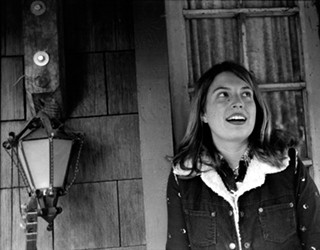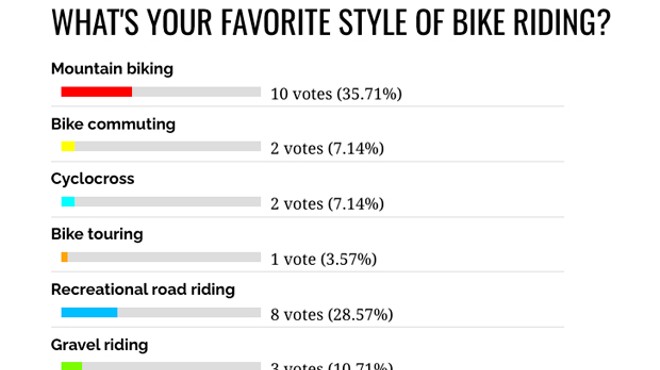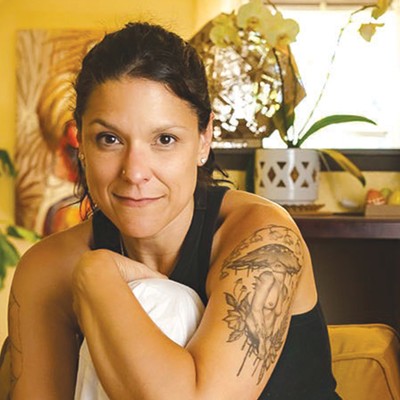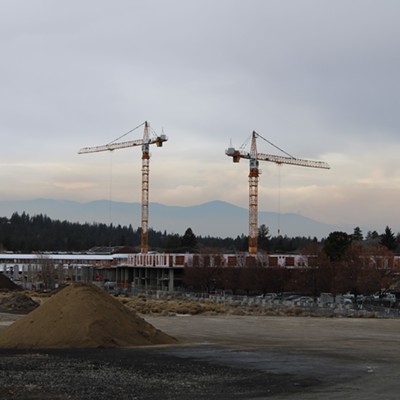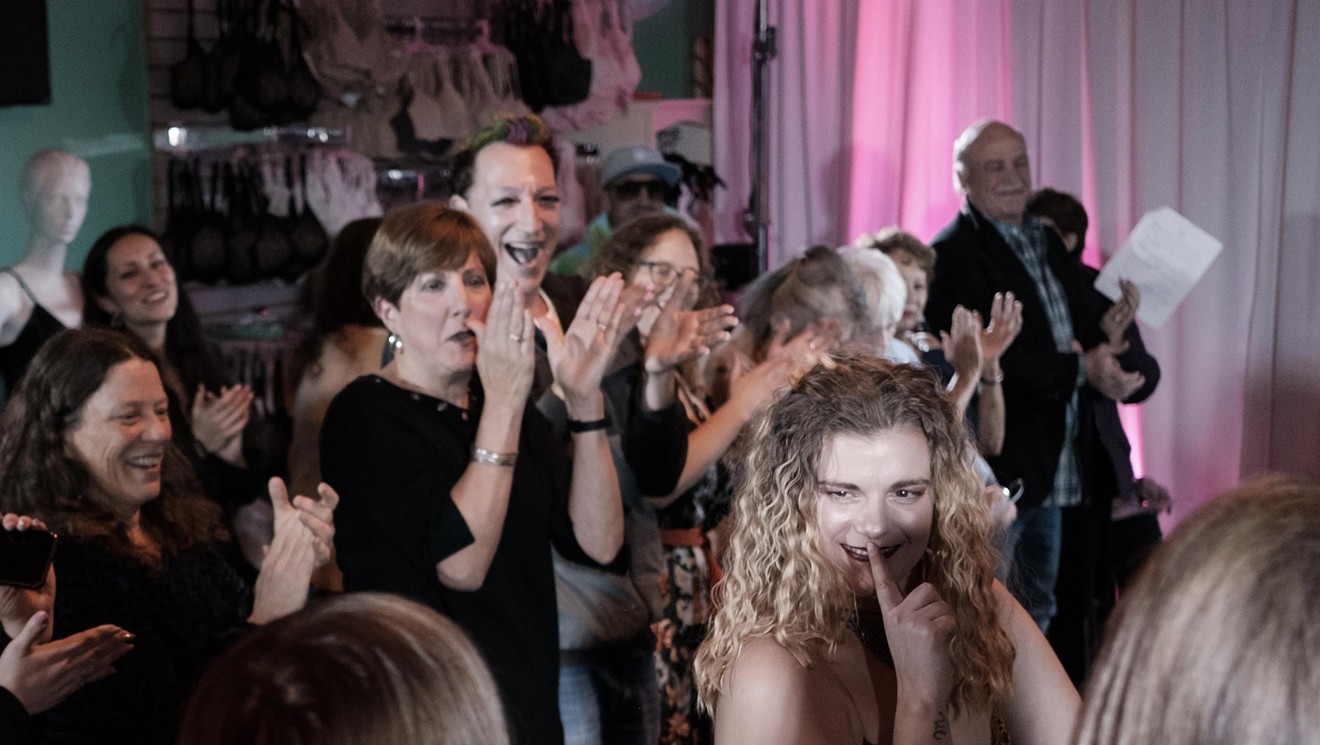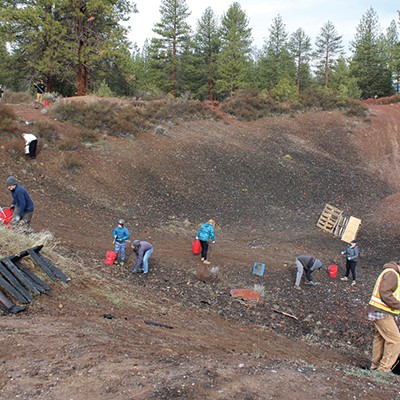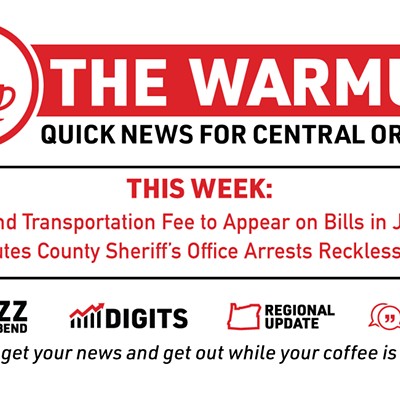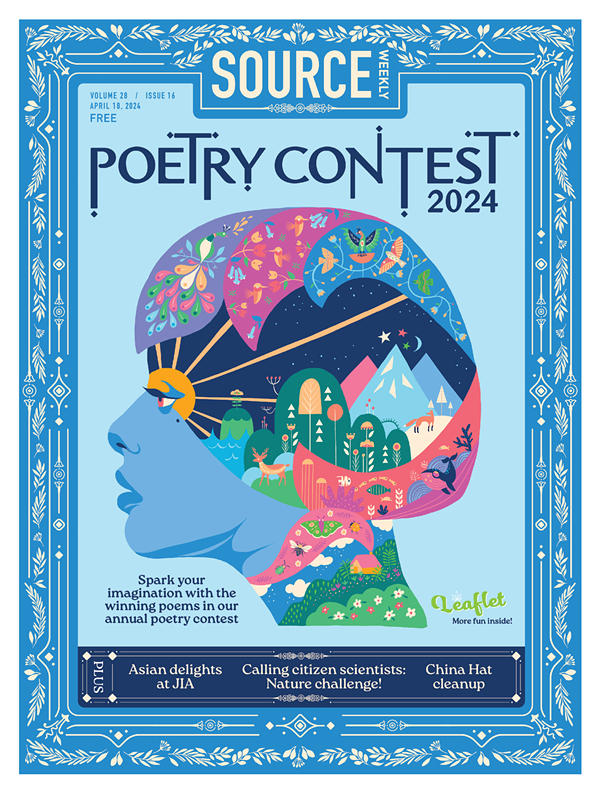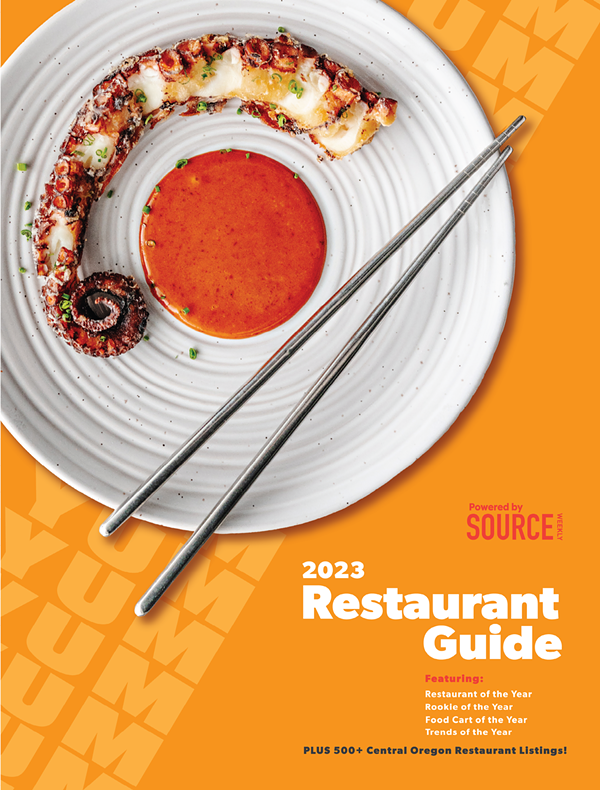Public outcry about traffic congestion and unsafe walking and biking conditions has the City of Bend's attention. As population growth continues to skyrocket, city leaders and citizen advisors are working on transportation solutions that will move Bend into the future.
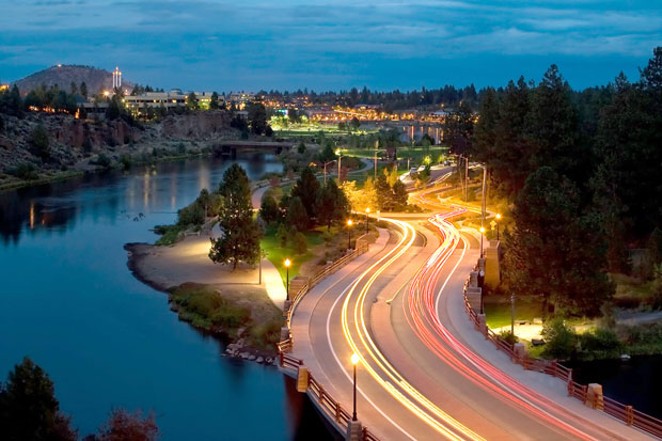
The city hasn't updated its transportation plan since 2001. Two years ago—with federal deadlines for the Bend Metropolitan Planning Organization's transportation plan fast approaching—the city council selected 25 locals for the Citywide Transportation Advisory Committee to work with engineers, city staff and a public relations firm to prioritize a list of 187 projects and programs. The committee was tasked with deciding on a plan that would carry the city through 2040, when Bend's population is projected to reach 143,000, according to Portland State University's Population Research Center.
Next week, the city will start a phone poll asking people in Bend whether they would support either a $190 million or $275 million bond for the committee's near-term project list. The smaller bond focuses on the most needed capacity improvements for roads and intersections, while also creating safer routes for cyclists, pedestrians and people who use wheelchairs. The larger bond goes further in addressing safety and capacity for all modes of transportation, aimed at helping the city stay ahead of projected growth.
"There's no question that there is a big backlog of road projects and that now we're playing catch-up," said City Councilor Bruce Abernethy. "It's not easy to ask citizens to pay for those. And I think it's confusing to people (that we're asking for bond money) because they are paying 21% of their property taxes to the city... but that goes to fire, police, affordable housing and streets, and there is not much left for large infrastructure projects to squeeze out of the General Fund. The system development charges only go so far."
The city collects SDCs from developers when they build new homes, in order to fund all the necessary infrastructure required for the buildings such as new streets, sewers, parks and water.
"The bond is really paying for a lot of back projects," Abernethy said. "Things that need to be done soon and can't be funded any other way."
Mayor Sally Russell chose two city council members, Gena Goodman-Campbell and Bill Moseley, and two CTAC members to put together the proposed bond packages. Karna Gustafson—a CTAC member who is the Central Oregon Builders Association's lawyer—advocated for traffic congestion relief and better roads for development. Mike Riley—executive director of the Environmental Center—made the case for increased multi-modal routes and money for public transit. While heated debates ensued on both sides during CTAC meetings, this smaller group worked quickly to come to consensus on the city's immediate priorities. After the results come in from the phone survey in the next few weeks, the City Council will vote on whether to put one of the bonds on the May 19 ballot.
Multi-Modal Transportation Planning
Goodman-Campbell—who sat on both CTAC and the bond subcommittee—believes the bond projects could be a big win for the multi-modal community, which includes people who walk, bike or use wheelchairs to get around.
Both bond proposals include $25 million for a network of 12 key multi-modal routes running north/south and east/west, designed as "low stress" networks for commuting. Route 3, for example, connects Shevlin Park from the west to Big Sky Park in the east, with improved lanes and sidewalks on NW Portland Avenue and a protected bike section on NE Olney Avenue as it passes under Highway 97. The bond would fund safe routes to schools, filling in sidewalk gaps and addressing some of the community's neighborhood safety concerns with crosswalks and intersection improvements. The smaller proposed bond designates $4 million for those projects, the larger $16 million. The City Council and the bond committee also agreed to prioritize at least one improved connection between downtown and the Bend Central District.
"There is a tension in our community of, 'what is the right balance?'" said Riley. "We've been very focused on moving cars, and I'm looking for a balance of investment in walking and biking, and we need to make it complete. We've really under-invested in those modes."
In 1971, Oregon was the first state to enact a "Complete Street" mandate requiring that new and rebuilt roads accommodate bikes and pedestrians. The act was a response to the nation's "automobile dependence" that emerged after World War II due to infrastructure and land use policies, according to Smart Growth America, a nonprofit coalition that advocates for sustainable growth solutions across the U.S. The City of Bend took things a step further, creating policies that produced redesigns such as NW 14th St., which includes a center turning lane, buffered bike lanes, sidewalks and bus stops.
Because of projected population growth, building out intersections is a short-term solution. If the 50,000 people that are moving here in the next 20 years are anything like Bend’s current population, it’s only going to be a matter of time before these intersections fail too because they’ll be full of cars anyway. If you want to make driving better for everyone, you have to make not driving better first.—Citizen Transportation Advisory Committee Member, Ariel Méndez
tweet this
Road Improvements
Moseley, who sat on the bond subcommittee and attended a few CTAC meetings early on, thinks the city should focus most of its efforts on relieving traffic congestion because he believes that's what voters asked for, according to a city-commissioned poll last spring.
DHM Research polled 303 voters in May and reported that 88% think traffic is a problem. Still, voters were not in agreement on how to fix it. Twenty-nine% said the city should widen roads and add more lanes while 9% said the city should build new bike/pedestrian paths. Sixty-nine% of Bend voters said they would support a bond measure to fund projects that reduced traffic congestion, and 72% would support a bond for neighborhood street safety.
"I had objections to the structure of CTAC and the people chosen for the committee," Moseley said. "Most of the people are in the multi-modal community because those tend to be the kind of people that are passionate about transportation issues. You don't have a lot of people (on the committee) who are swearing in their cars every afternoon when they're stuck in gridlock on Reed Market. Those people don't show up to City Council meetings."
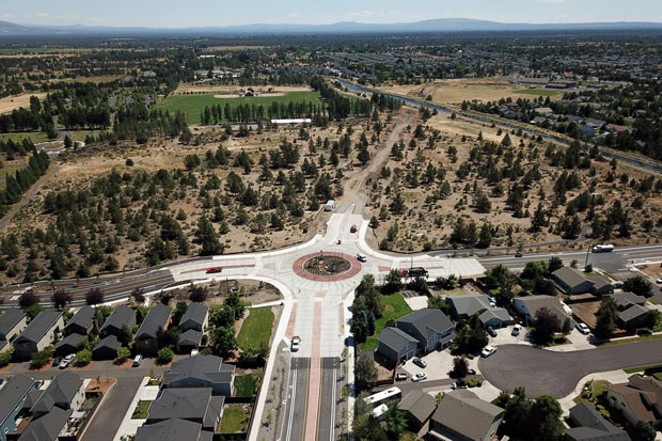
The bond committee chose a number of capital projects they believe will contribute to noticeable traffic improvements, including:
- Improvements at SE Reed Market Road overcrossing of Highway 97 and BNSF Railway, improving roundabout at NE 15th Street
- Increasing the capacity of SW/NW Colorado Avenue from SW Simpson Avenue to NW Arizona Avenue by improving traffic flow at intersections/roundabouts and fixing the Colorado Bridge
- Intersection improvements at high-crash and high-fatality intersections.
Ariel Méndez, a bike advocate who sat on CTAC and is on the board of Bend Park and Recreation District, believes the deck was stacked in favor of large infrastructure projects from the beginning because the committee had to meet a deadline for the Bend Metropolitan Planning Organization's transportation plan.
Méndez believes that the city can reduce congestion and meet the state mandate for decreasing Vehicle Miles Traveled through policies such as Travel Demand Management, where the city would work with local employers to stagger morning and evening commutes.
"Because of projected population growth, building out intersections is a short-term solution," Méndez said. "If the 50,000 people that are moving here in the next 20 years are anything like Bend's current population (in terms of driving), it's only going to be a matter of time before these intersections fail too, because they'll be full of cars anyway. If you want to make driving better for everyone, you have to make not driving better first."
Currently Méndez is working with BPRD to support safe routes to schools and parks, promoting the concept that city trails can be used for transportation as well as recreation.
Cascades East Transit
Public transit may also win big if a transportation bond passes, with $11.7 million designated to Cascades East Transit in the large package and $7 million in the smaller bond.
The CET Development Plan is still in the works, but the bond money could support faster and more frequent trips heading north/south and east/west with infrastructure improvements such as designated bus lanes and stop lights timed to the bus schedule.
One of the most visible changes may be the addition of "mobility hubs"—smaller stations throughout the city at tentative locations including St. Charles Medical Center, downtown, Oregon State University-Cascades, Walmart and NE Robal Lane, according to an Oct 7 CET memorandum.
The mobility hub concept is taking root across the country as a place that is more than just a transit center: Instead, shared scooters, bikes and ride-sharing drivers help people reach their final destination. CET is also considering investing in a fleet of smaller buses that would function more like ride shares leaving from each hub instead of operating on fixed routes and schedules.
The hubs may also lessen the impact of Hawthorne Station, CET's transit center on NE Hawthorne Avenue. Neighbors and businesses in the Bend Towne Center next to the station have been complaining about congestion and safety issues for years. They hired a public relations firm in the spring of 2018 and a land use attorney this fall. In November, they hired Joe Bessman of Transight Consulting to conduct a transit study that they submitted to the City. Bessman concluded that the station is out of compliance for ODOT standards and is the only station in the country that operates 100% on city streets, instead of reserving a decidated off-street area. Erin Foote Morgan, of Hubbell Communications, representing BTC, said the city has not adequately integrated transit into the 20-year Transportation System Plan, but the fact that they are considering capital funding in the bond is a good sign.
"Transit should have been the first question in the planning process: for climate change, for Bend's low-income community, for affordability, for truly relieving our congestion problem, but it is the last conversation," Foote Morgan said. "Transit is a solution that many other communities have discovered but there is very little leadership around it in our community."
While a majority of city councilors support funding for CET in the bond, Councilor Justin Livingston said the transit provider will already be getting enough money from the State of Oregon in coming years. In 2017, the Oregon State Legislature passed House Bill 2017 which will expand public transit services through a 0.1% regional payroll tax.
Oregon Department of Transportation
The proposed bond would also support a number of ODOT projects along Highway 97. While they may appear as small line items, the city's contributions are usually just a fraction of the cost of much larger infrastructure overhauls that should eventually solve some gridlock issues along the parkway, according to City Manager Eric King.
The bond would provide $14 million for the "US 97 Parkway Plan" which may close on and off ramps, add timed stop lights to pace traffic during rush hours and add a deceleration lane at the NW Hawthorne Avenue exit. Early next year, ODOT will begin construction on safety improvements on Highway 97 between Bend and Redmond including more street lights, turn around lanes and improved infrastructure at major intersections.
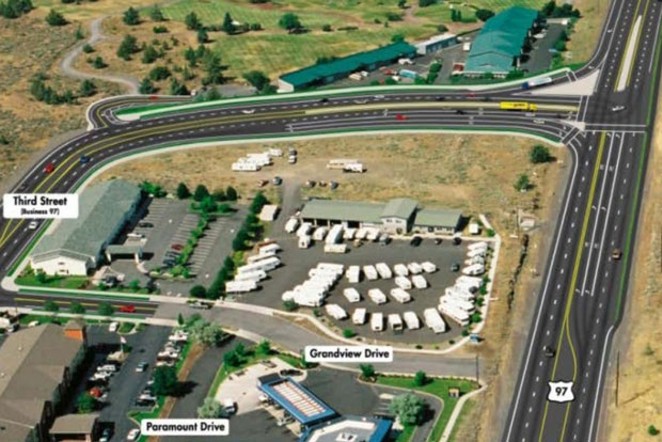
ODOT's biggest undertaking in the region is the North Corridor Project, which will cost $324 million and include an overpass over Cooley Road, along with a new section of highway bypassing the traffic lights at the Cascade Village Shopping Center. The current portiona of Highway 97 between NE Robal Lane and Cooley Road will turn into a local route, and join up with Highway 97 at a new intersection that will be built a few blocks north of Space Age Fuel. The city won a $60.4 million Infrastructure For Rebuilding America grant from the federal government. ODOT is contributing $73 million, the City of Bend is putting in $2.5 million and Deschutes County is adding $5 million.
Méndez, as a member of CTAC, thinks the project is a "terrible idea" and a waste of taxpayer money. The total cost for the project is $324,592,000, which equals about $3,000 for every person in Bend, though the majority of funds are coming in from the state and federal government. His main concern is that because ODOT will build a new stoplight on Highway 97 less than a half mile north of the one at Cooley Road—a great deal of taxpayer money may be spent recreating existing conditions.
This is not philosophical for me. I just don’t believe in changing people’s behaviors. It’s not like I’m in love with these square metal boxes with wheels. I live a half mile from work and walk there every day.—Bend City Councilor Bill Moseley
tweet this
Communicating the need
If the City Council decides to put on the bond on the May ballot, the next challenge will be clearly communicating the costs and benefits of the projects to Bend voters.
"One of the issues is that—spend too little, and there may not be many tangible changes—spend too much and voters may reject the bond altogether," Abernethy concluded. "The other issue is that it (the bond) is very complex, and it is perhaps futile and counter-productive to try to divide projects by how they benefit drivers vs. pedestrians and bikes. Many of these projects improve transportation for both drivers and multi-modal advocates."
"This is not philosophical for me," said Moseley. "I just don't believe in changing people's behaviors. It's not like I'm in love with these square metal boxes with wheels. I live a half mile from work and walk there every day."
"We should all be happy about this," said Goodman-Campbell about the bond committee's project lists. "We're going to have all these bike routes done in the near term.
"We can't promise to solve all of the transportation problems, but what we can show is that we are listening to what people have been saying. We'll tackle those biggest needs first to keep people moving safely around Bend."

